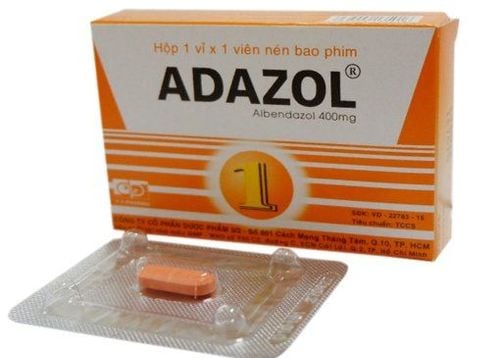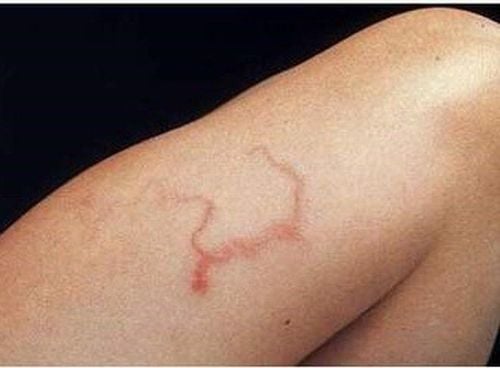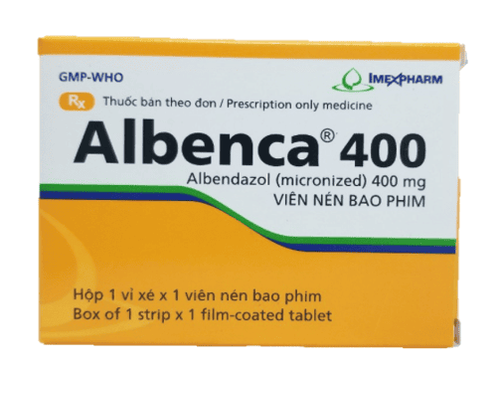This is an automatically translated article.
The article was professionally consulted by Doctor Vo Ha Bang Suong - Doctor of Medicine - Department of Medical Examination & Internal Medicine - Vinmec Phu Quoc International General Hospital. The doctor has more than 15 years of experience in the treatment of internal diseases.Is toxocariasis in humans a cause for concern? Toxocariasis is not dangerous, but if detected late, it can lead to complications in many organs and even death.
1. Outline
Toxocariasis (Several other strains related to toxocariasis: Toxocara cati or commonly known as feline roundworm (discovered and published by Schrank., 1788 and Brumpt., 1927) appears everywhere regardless of the disease. In rural or urban areas, even advanced countries can still be infected and even infected. of dogs, found in 80% of dogs in the tropics and 17 - 20% of dogs in temperate regions.Adult worms live in the small intestine of puppies under 3 to 6 months of age; each day the worms lay about 200,000 eggs, worm eggs in feces Dogs go out and can live outside for many months; when the dog gets older, due to the immune mechanism, the intestinal worms will be pushed out.If the puppy swallows the eggs, some larvae enter the lungs and develop into adult worms in the small intestine, others continue to move in internal organs.As the dog grows and becomes pregnant, the larvae pass through the placenta, infect the fetus, or enter the mammary gland. y infects puppies while they are nursing.Humans are infected by ingesting adult eggs or by eating other hosts containing larvae. Children from 1 to 4 years old will have a higher incidence of the disease. The habit of eating soil is commonly seen in children infected with Toxocara canis. After digestion, the larvae separate from the adult eggs and travel to other organs by way of travel in the body. They can also travel several times to tissues, eventually encapsulating into larvae and forming granulomas, increasing eosinophils in all major organs of the body, including the brain and eyes.
2. Morphology
Males measure 4-10cm and females 6-18cm. The shape looks like a young roundworm, the hooks of the neck worm are narrow at the end. Eggs are semi-lobed, thick, with pitted shell, size 90 x 75micron.3. Mode of infection
3.1 In dogs and cats Direct by way of ingestion of eggs contaminated with larvae from the soil. Indirectly by eating carnivorous hosts Perinatal infection (T.canis only) Ingestion of larvae via fecal route Milk transmission
Bệnh sán chó mèo ở người nguy hiểm như thế nào?
4. Clinical features
When canine roundworms enter the human body, they will "travel" in the human body for several months to years, causing damage to the parts of the body they pass through. People infected with tapeworm often have itchy skin again and again, treatment does not completely stop. In addition, in some people, there is an enlarged liver; fever or lung symptoms such as cough, chest pain; stomachache, indigestion. These symptoms can last for months or years, and patients rarely think about being infected with worms.The extent of damage to the body along with symptoms depends on the number of larvae as well as the organs they invade including organs such as liver, lungs, central nervous system, eyes... In which , the two most common forms are visceral and ocular migratory larvae.
In the viscera, the patient has symptoms of fever, enlarged and necrotic liver, splenomegaly, respiratory symptoms resembling asthma.
In the eyes, the most common symptom is decreased vision in one eye or sometimes crossed. The degree of vision loss depends on the affected area (retina, macula), which can lead to permanent blindness.
5. Types of toxocariasis in humans
5.1. Disease caused by larvae of Toxocara spp. visceral migration Visceral migration is more common in children aged 1-4 years than in adults. The disease begins slowly. Patients may experience transient mild fever, little appetite, emaciation, diarrhea, nausea, vomiting, and muscle and joint pain. Coughing up sputum with eosinophilic infiltrates, dyspnea, hepatomegaly, smooth surface, painless, sometimes accompanied by splenomegaly. The disease can resolve on its own after many weeks when the larvae die.In adults, infection is sometimes asymptomatic, or if present, presents with low-grade fever, fatigue, weakness, pruritus, urticaria, pseudo-asthmatic dyspnoea, wheezing, pneumonia, pleural effusion lungs, and, rarely, respiratory failure.
The liver is the most commonly affected organ and hepatomegaly is a common manifestation, although any organ can be affected. Liver damage is like a tumor that can easily be mistaken for cancer or cancer that has spread elsewhere. The literature has recorded many cases of splenomegaly or associated lymphadenopathy, and skin lesions such as urticaria and subcutaneous nodules have also been reported.
Some cases cause myositis, subcutaneous tissue inflammation, ascites, gastritis, dilated cardiomyopathy, pseudotumor in the heart causing sudden death. In severe cases, many organs are infected such as liver, spleen, lung, brain. Infection with Toxocara spp. disseminated in immunocompromised patients.
5.2. Disease caused by larvae migrating to the nervous system is one of the special diseases of visceral larva migrans, often seen in middle-aged patients. Patients often have symptoms related to nervous system such as sleep disturbance, muscle weakness, limb weakness, muscle weakness, urinary and bowel disorders. Injuries to the central nervous system are rarer, but can have serious complications and result in muscle weakness, sensory disturbances, convulsions, seizures, and coma.

Bệnh sán chó mèo không nguy hiểm nhưng nếu phát hiện muộn có thể gây tử vong
5.3. Migratory larval disease caused by Toxocara spp. ophthalmic Disease caused by larval migration of the eye is also common in older children, with or without Toxocara spp. other organs. Larvae can cause vision loss usually in one eye, with the exception of bilateral effects, ophthalmoscopy shows retinal granulitis, conjunctivitis, intraocular granulomatosis, larval endophthalmitis live or dead migration causes immune reactivation. Blindness can occur as a result of iritis, tissue edema, and retinal detachment that are not treated promptly. Typical symptoms include decreased visual acuity on one side, eye pain, white pupils, and crossed eyes that last for several weeks. The most common is posterior pole retinoblastoma, easily confused with retinal cancer. Sometimes in the eyes, uveitis, vitreous abscess, optic neuritis and superinfection are also encountered. Usually one eye is affected, rarely both eyes. Eye disease usually does not show eosinophilia, hepatomegaly or other symptoms common to visceral larva disease, as well as a history of playing with the ground, eating dirt (pica), or playing with dogs or kittens. .
5.4. Disease caused by larvae of Toxocara spp. atypical The occult form in children and often in adults is a syndrome that challenges clinical diagnosis because of its nonspecific symptoms. Symptoms may include fever, loss of appetite, headache, wheezing, nausea, vomiting, weakness, sleep and behavior disturbances, pulmonary symptoms, limb pain, swollen lymph nodes in the neck, and an enlarged liver. common in children. In contrast, fatigue, pruritus, erythema, pulmonary symptoms, and abdominal pain were mainly seen in adults. Cases with individual symptoms are unique, but when combined they form a syndrome known as "atypical Toxocara spp. disease".
5.5. Disease caused by larvae Toxocara spp. other Cases that do not fall into the above categories, this other type includes pathology caused by larvae of Toxocara spp. Cardiovascular related such as myocarditis, pericarditis, skin related such as erythema, gastrointestinal related such as gastrointestinal disorders, diarrhea, abdominal pain.
6. Diagnosis
Disease caused by larvae of Toxocara spp. disease group C in the Law on Prevention and Control of Infectious Diseases of Vietnam. According to the definition of toxocariasis case of dogs/cats issued by the Ministry of Health together with Decision No. 4283/QD-BYT dated August 8, 2016 on the Issuance of the Document “Definition of an infectious disease case” which mentions Confirmed cases include the following criteria:Itching, rash; Headache, abdominal pain, indigestion; Aching pain, numbness; Fever, wheezing; May be accompanied by one or more of the following symptoms: hepatomegaly, pneumonia, chronic abdominal pain, focal neurological disorder, eye damage, visual disturbance, eye inflammation, retinal damage; Anti-Toxocara antibodies spp. IgG positive by ELISA test; Or find larvae or adult toxocariasis; Or detect specific gene fragment of dog or cat roundworm larvae by molecular biology technique. Definitive diagnosis is based on detection of Toxocara larvae in tissue samples, but biopsy of tissue containing larvae can be difficult and complicated, even with complications. Therefore, diagnosis is often based on clinical features and serological tests, however, clinical manifestations are often atypical and non-specific, leading to difficulty in making a definitive diagnosis.
7. Treatment
Possible use:Thiabendazole 25mg/kg body weight, twice daily for 21 days. Diethylcarbamazine 3mg/kg body weight 3 times/day for 21 days. Albendazole has also recently been shown to be effective in toxocariasis, at high doses of 800 mg/day for 2-3 weeks. Antiallergic drugs: Telfast, cetirizine, loratadine... In some cases, it may be necessary to use a combination of antiparasitic drugs with corticosteroids or surgery (Toxocara infection in the eye)
8. Preventive measures
Minimize contact with susceptible hosts, infected cats and dogs and the environment with suspected disease; Check the pups' poop weekly and deworm every month until the poop becomes negative; There should be a routine yearly stool examination and the necessary treatment plan; Do not allow dogs to run in children's play gardens, parks or shelters; Quickly remove containers of dog feces; Strictly control and tie the leash, or have clear farming rules. Health education by veterinarians, physicians, activists and pet owners to contribute to disease prevention and control. Wash children's hands after playing in sandy areas and pets. Health education for parents avoids potential risks. Toxocara canis larvae penetrate the human intestinal wall and are transported via the bloodstream to the liver, lungs, brain and other organs. In these organs, larvae wander for weeks or months, or lie dormant, into foreign bodies that cause inflammation and stimulate granulomatosis. However, because humans are random hosts, the parasites never develop to adulthood. Therefore, eggs cannot be found in the feces of an infected person.
In children, it has been shown that children from 4 to 12 years old often have neurological diseases caused by infection with roundworms in dogs and cats. "Most of the pediatric patients are children with risky behaviors such as contact with dogs and cats, contact with soil... Children in kindergartens or kindergartens often like to play with the ground, eat dirt, lick toys, suck their fingers. . 30% of children in this age group often put their hands in their mouths, and older children play a lot of games that come in contact with the ground such as soccer, holding dogs and cats...," . In adults, the disease is common in all ages, especially in working age. The disease usually occurs in people who do not wash their hands after touching the soil, playing and holding dogs and cats. If possible, only let children play in places where there are no dogs or cats. Adults must educate children about personal hygiene, especially washing hands before eating. For cats and dogs that are kept as pets in the house, we need to periodically deworm them.
Toxocariasis is a preventable and treatable disease, the sooner the better. A reliable address for you to be examined and treated is the Vinmec hospital system. With a team of qualified, experienced and enthusiastic medical doctors, you can rest assured when taking care of your health here.
Please dial HOTLINE for more information or register for an appointment HERE. Download MyVinmec app to make appointments faster and to manage your bookings easily.













